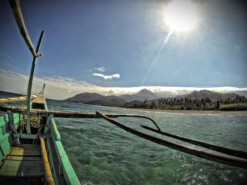Suspected phantom tankers in the Riau Islands at a ‘base’ with network connections,
According to the latest International Maritime Bureau (IMB) incident report, now more than half of the world’s piracy attacks are occurring in South East Asia. Piracy in the Gulf of Aden, which was the scourge of global shipping from 2011-14 has all but disappeared. But the problem is far from solved, whilst global piracy has dropped overall in the past few years the start of 2015 has seen a consistent rise in attacks.
Responsible for this increate are both the Gulf of Guinea, which remains a hotspot for armed robbery at sea and kidnap for ransom, and south east Asia. Piracy in the waters off Indonesia, the Malakka and Singapore Straights has risen almost exponentially, representing almost 40 per cent of 2015 attacks globally.
The majority of these incidents related to illegal oil bunkering. Singapore is the bunkering capital of the world, with incidents even occurring within the city-state’s famous port. Vessels arrange illicit ship-to-ship (STS) transfers without paying the proper fees and avoid the designated areas. Weak legislation and lax fines are abused as primarily Singapore-flagged and owned vessels bunker with their automatic identification systems (AIS) shut off to avoid suspicion. This lucrative industry with individuals able to earn between €30,000 up to €500,000 for each successful hit.
What is curious therefore, is the lack of response from the regional or international community to address the threat. Unlike Somali piracy, SE Asia has failed to capture the headlines; it has not triggered multi-lateral naval patrols or the proliferation of high-level strategies that we have seen in the Horn, or even in West Africa. Why?
- SE Asian piracy has been downplayed in past years, and has been described as unorganized and low-level – more appropriately described as theft at sea, rather than genuine piracy.
- The successful heists themselves have been of quite small amounts, which has lead to chronic under-reporting, as the value of the cargo is less than the cost to insurance premiums if the region were to be considered in a higher risk category – a jeopardy faced by shipping companies already in the Gulfs of Aden and Guinea. The Director of the IMB has estimated that 70% of attacks on ships in SE Asia go unreported.
- There is significant demand in the region for the illicit product. Despite globally falling oil prices, stolen oil is still cheaper than market prices, and the evidence shows that the primary market for the stolen oil is China. Though Chinese growth has slowed to single digits, the demand for discounted oil is always far greater than supply.
There are a number of challenges presented to the countries in the region to respond: first, the body of water is vast, and filled with thousands of islands – there are 14,000 small islands in the Indonesian archipelago alone – making it almost impossible to conduct effective surveillance. Secondly, the complex division of national authorities makes cooperation a challenge. Past efforts have focus on sea-based activities, but even where interdiction has been possible, the lack of tools for legal cooperation and mutual legal assistance have proved a hindrance for subsequent prosecution.
Political will appears to be low for getting serious about SE Asia piracy, but this apathy has allowed serious and organised criminal syndicates to proliferate and professionalize into ‘logistical masterpieces’ that are developing corruption networks to protect their activities. Karsten von Hoesslin of Risk Intelligence, who has spent many years investigating and tracking these networks explains: “Today, everything is pre-planned and is part of a larger criminal activity. It is very easy to counterfeit legal papers for the products such as palm oil, gas or petrol and to transport them.”
SE Asian piracy follows a scheme of stealing product and value whilst avoiding the excessive violence, hostage taking and hijacking of African piracy – arguably another reason why it has failed to gain headline attention.
On average a team of 7-12 pirates will usually board the attacked vessel for a period of time (an estimated six to ten hours) in order to proceed with the siphoning of product whilst the original crew is gagged and bound. Since no individuals are kidnapped for ransom, a reasonable degree of violence can be expected, although usually only light weapons are used. These incidents all occur usually under the cover of the night. Stolen goods are then carried on a phantom ship, with another 15 pirates manning the vessel, which will take the stolen crude to be blended, refined and sold under the cover of counterfeit documents. These attacks occur on sea and require a high level of logistic know-how as well as coordination between the actors on and off-shore.
According to von Hoesslin, there are between 6-8 key criminal networks at play in SE Asia, but like any criminal enterprise these are supported by vast networks of corrupt officials, facilitators, money launders and low level operatives that are spread across all of the countries in the region.
His analysis shows a organisational structure (shown below) with a handful of group leaders who move about with impunity, connected to a dozen fixers or middle men from all over the region; they connect to half a dozen known known buyers of illicit crude who eagerly bargain down the price of the illicit product. There are at least four skilled forgers in play to supply false purchase and registration documentation, nearly ten phantom ships to hire out, and of course countless numbers of individuals willing to be insiders or part of the networks. The modus operandi of hijacking for product theft is deeply embedded in South East Asian shipping affairs in what many have described as a deeply corrupt industry. Insiders within the industry and of the targeted vessel carrying fuel are crucial for the group to gain valuable information where and how fuel and oil can be siphoned.
With ICC and IMB reports suggesting that there is a crude oil hijacking in SE Asian waters every two weeks, the region is arguably needs renewed focus in the war on maritime crime, and the growing consolidation and professionalisation of criminal networks should be of concern for the integrity of the states in the region. It is time for us to get serious about SE Asia piracy.
Later this year, the Global Initiative against Transnational Organized Crime looks forward to publishing a full report by Karsten von Hoesslin on SE Asia piracy, its genesis as a regional criminal industry, examining and analysing the business model, the networks at play and the implications for international security and trade policy.
Piratería en el Sudeste Asiático: redes criminales, complot empresarial y corrupción
La fotografía de portada muestra 2 barcos petroleros aparentemente fantasmas en las Islas Riau en una “base” con su red de contactos.
Fuente: von Hoesslin
De acuerdo con el último informe de incidentes del IMB (International Maritime Bureau), más de la mitad de los ataques piratas que se dan actualmente en el mundo ocurren en el Sudeste de Asia. Si bien la piratería en el Golfo de Adén, flagelo del transporte marítimo mundial entre 2011 y 2014, ha prácticamente desaparecido, el problema está lejos de ser resuelto – mientras que la piratería a nivel mundial en general ha disminuido en los últimos años, desde el inicio de 2015 hemos presenciado una escalada constante de ataques.
Los responsables de este aumento son tanto el Golfo de Guinea, que sigue siendo un centro para los robos a mano armada en altamar y para los secuestros por rescates, y Asia Sudoriental. La piratería en las aguas de Indonesia y en los Estrechos de Melaka y de Singapur ha crecido casi exponencialmente, representando casi el 40 por ciento de los ataques a nivel global durante 2015.
La mayoría de estos acontecimientos están relacionados con el robo de petróleo. Singapur es el principal abastecedor mundial de combustible para los barcos, en donde suceden incidentes incluso dentro de su famoso puerto. Los buques arreglan transferencias buque a buque sin pagar las tarifas estipuladas y evitan las áreas designadas. Los barcos principalmente de bandera nacional apagan sus sistemas automáticos de detección mientras llevan a cabo la transferencia y así evitan levantar sospechas, aprovechándose de este modo de las legislaciones débiles y de las multas tolerantes. En este comercio, los individuos pueden llegar a ganar entre 30.000 y 500.000 euros por cada movimiento exitoso.
Lo curioso es la falta de respuesta de las comunidades regionales e internacionales. Contrario a la experiencia con la piratería en Somalia, el SE asiático no ha logrado llamar la atención; no ha provocado acciones multilaterales de patrullaje naval o la proliferación de estrategias de alto nivel que se han visto en el Cuerno de África e incluso en África Occidental. ¿Por qué?
- En los últimos años, se ha minimizado la magnitud de la piratería en el SE de Asia, y ha sido considerada desorganizada y de bajo impacto, más bien descrita como robo en altamar y no como piratería genuina.
- Incluso lo ataques exitosos han sido por cantidades bastante pequeñas, lo que ha llevado a que durante mucho tiempo no se denuncien debido a que el valor del cargamento es menor que el costo de las pólizas de seguro si a la región se la ubicara en la categoría de alto riesgo – un riesgo al que las empresas de transporte ya se enfrentaban en los Golfos de Adén y de Guinea. El director de IMB estima que el 70% de los ataques a los barcos en el SE asiático no son denunciados.
- Existe una demanda importante de petróleo ilícito en la región. A pesar de que el precio del petróleo viene en baja en todo el mundo, el petróleo robado es todavía más barato que en el mercado legal, y la evidencia muestra que el principal comprador de petróleo robado es China. Si bien el crecimiento chino ha descendido a un dígito, la demanda de combustible a precio reducido es siempre muy superior a la oferta.
Existen varios desafíos a enfrentar en los países de la región: primero, la gran dimensión de zonas cubiertas por agua, con miles de islas esparcidas – hay 14.000 islas pequeñas sólo en el archipiélago de Indonesia – que imposibilita una supervisión efectiva de la región. Segundo, la compleja división de autoridades nacionales hace de la cooperación un desafío. Los esfuerzos pasados han hecho foco sobre las actividades en el mar, pero incluso cuando se ha logrado interceptar a barcos piratas, la falta de herramientas para una cooperación jurídica y para una asistencia jurídica mutua ha probado ser un obstáculo para el enjuiciamiento subsiguiente.
La voluntad política parece no ser lo suficientemente alta como para abordar seriamente la piratería en esta región del mundo. Pero es esta misma apatía la que ha dado lugar a que las organizaciones criminales serias proliferen y evolucionen hasta lograr llevar adelante grandes obras de logística que a su vez dan lugar a redes de corrupción para proteger sus actividades. Karsten von Hoesslin, de Risk Intelligence, quien desde hace varios años viene investigando y localizando estas redes, explica: “Hoy por hoy, todo está planeado y es parte de una actividad criminal mayor. Es muy fácil falsificar documentos jurídicos de productos como el aceite de palma, el gas o el petróleo y transportarlos.”
La piratería en el sudeste asiático se basa en el robo del producto evitando la violencia excesiva, la toma de rehenes y los secuestros, métodos propios de la piratería africana – podría decirse que esta es otra razón por la que no ha logrado captar la atención pública.
En promedio, un equipo de 7 a 12 piratas aborda el barco bajo ataque por un período de tiempo que se estima va entre seis y diez horas para proceder con el robo del producto mientras que la tripulación original está amarrada y amordazada. Ya que no piden rescate por ninguno de los individuos, puede esperarse un grado razonable de violencia, aunque normalmente sólo utilizan armas ligeras. Este tipo de incidentes suele ocurrir en la oscuridad de la noche. Los bienes robados son posteriormente llevados a un barco fantasma, con otros 15 piratas tripulándolo, el cual será utilizado para llevar el crudo robado para ser mezclado, refinado y vendido con documentación falsa. Estos ataques ocurren en altamar y exigen un gran conocimiento y nivel de logística como también de coordinación entre los actores en tierra y en mar.
De acuerdo con von Hoesslin, en el sudeste asiático existen entre 6 y 8 redes criminales principales, pero al igual que cualquier otra empresa criminal, estas pueden operar gracias a vastas redes de oficiales y facilitadores corruptos, blanqueo de dinero y operadores de bajo nivel esparcidos por todos los países de la región.
Su análisis muestra una estructura organizacional (abajo) que cuenta con unos varios grupos de líderes que se movilizan con impunidad y están conectados con una docena de facilitadores o intermediarios en toda la región; a su vez, estos están conectados con unos seis compradores conocidos de crudo ilícito que están muy dispuestos a intentar bajar el precio del producto ilícito. Pueden verse por lo menos cuatro falsificadores capacitados en juego para proveer documentación falsa de compra y registro, aproximadamente diez barcos fantasmas para alquilar, y por supuesto un sinfín de individuos dispuestos a corromperse o ser parte de la red. El modus operandi para hacerse del producto está profundamente incrustado en los asuntos de transporte en el sudeste asiático en lo que muchos han descrito como una industria extremadamente corrupta. Los individuos con información privilegiada dentro de la industria y de los buques objetivos son cruciales para que el grupo obtenga información valiosa sobre dónde y cómo puede desviarse el combustible y el petróleo.
Visto que el informe de ICC y IMB sugiere que existe un robo de crudo cada dos semanas en las aguas del sudeste de Asia, puede decirse que la región necesita un foco renovado sobre la guerra contra la delincuencia marítima, y que la creciente consolidación y profesionalización de estas redes criminales debería ser una preocupación para la integridad de los Estados de la región. Es momento de tratar seriamente la piratería en Asia Sudoriental.
Próximamente, Global Initiative against Transnational Organized Crime espera publicar un informe completo de Karsten von Hoesslin sobre la piratería en el sudeste asiático, su génesis como industria criminal regional, y un análisis del modelo de negocios, las redes en juego y las implicancias para la seguridad nacional y las políticas en materia de comercio.



